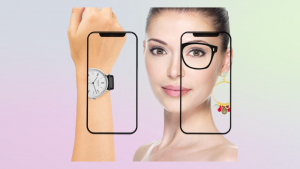Augmented reality (AR) has found use in multiple areas of human activity. Not only is it a fun engagement-boosting tool – the applications of web-based AR are only limited by a developer’s creativity.
From its foundational components to real-world applications and future possibilities, this guide dwells on the transformative potential of the newest Web AR technology advances, with ideas that both business owners, developers, and augmented reality enthusiasts will find insightful.
What Is Web AR?
Web augmented reality is a technology that allows users to access AR directly from the browser. So, unlike virtual reality software that requires an app to function, to experience Web AR, users only need a device with a camera and an internet connection.
How exactly does it work from the user’s perspective? Users scan a QR code or follow a link to open a dedicated web page in their browser. The browser then requests access to the device’s camera and displays the camera input directly on the web page. At the same time, the software adds digital elements based on the identified objects, also called markers.
As a result, the browser window shows a stunning combination of the physical and digital realms. When displayed via smartphone, the AR elements can be interacted with: viewed from different angles, moved around the place, etc.
The Technical Nuance Behind Web AR
WebAR experiences are becoming more advanced because mobile devices are adding new features that can support them. While every kind of AR uses the device’s camera, web-based mobile AR can as well have access to the phone’s gyroscope, accelerometer, orientation, and magnetometer.
Most experiences based on the newest Web-Based AR technology rely on these four key technical features.
- Six Degrees of Freedom (6DoF) refers to the ability of Web AR to position a digital model accurately within a real-world environment. The phone tracks the model’s orientation and position along three axes.
- Camera stream access allows Web AR to blend virtual content seamlessly with the real world by using the device’s RGB camera to provide perspective and field of view. With no data collected or stored, augmented reality online can show just as strong an image as any app-based solution.
- Scene understanding is essential for AR to place 3D objects within a physical space. This involves the device’s ability to map surfaces and estimate where the light comes from in an environment.
- A cloud-based content management system enables users to access augmented reality experiences through various triggers such as QR codes, links, markers, or facial recognition. This allows interactive content to be easily embedded anywhere with just a simple capture of the lens.
Despite a surprising amount of nuance, Web AR is a simpler and more affordable choice for those who want to get started with augmented reality. While the fact that it is cloud-based limits the range of the technology’s capabilities, Web AR is tailored to function flawlessly on any device from budget options to flagship phones.
Web AR Vs In-App AR – What’s The Difference?
If you want to enable AR technology for your business, there are two main ways of implementing it. You can choose to develop an app or incorporate Web AR into your product.
The key difference of an app-based AR from Web AR is that the in-app option stores the software elements and the data needed to render an augmented piece in the application.
Other than that, it is pretty straightforward: the app uses your device’s camera to show 3D content on top of what you see around you. It works together with your device’s hardware, like the camera, gyroscope, and accelerometer. The digital input (sound, text, graphics, or GPS data) is then augmented with the software and the combined image is created.
While app-based AR can offer more advanced features than Web AR, users need to download the app to experience them. This condition makes things tougher, especially if people have limited storage space or their device isn’t compatible. Studies show a 50% drop in engagement when users have to go through a download. Besides that, only 25% of people use the app beyond the first interaction.
Comparison Table
| Features | Web AR | App-based AR |
| Available on any device | X | |
| Supports any operating system | X | |
| Compatible with web analytics tools | X | |
| Not limited by browser performance constraints | X | |
| Provides advanced capabilities by utilizing the device’s hardware | X |
Use Cases Of Web Based AR
The use of augmented reality is only limited by a developer’s creativity. One of the recent marketing trends implies crafting unique user experiences for your customers. And nothing says unique better than immersive try-on, 3D face filters, or the capability of instantly changing the background during a video call.
Web-based AR can be applied in multiple ways across various industries. Below are just some of the compelling use cases. As the technology continues to evolve, we can expect to see even more innovative use cases emerging in the future.
WebAR for Retail and E-commerce
WebAR enables customers to visualize products in their own environment before making a purchase. This applies to furniture, wallpapers, clothing, accessories, or even plastic surgery. For example, customers can use their smartphone to see how furniture or home decor items would look in their living room.
Or customers can try on clothes, shoes, glasses, or even nail polish to see if they suit their looks before buying. This immersive shopping experience increases engagement and reduces return rates, leading to higher customer satisfaction and increased sales.

AR for Education
WebAR can enhance learning experiences by making educational content more interactive and engaging. One of the examples is healthcare: medical students can use WebAR to explore 3D models of the human face and body, examine organs and systems from different angles and gain a deeper understanding of complex concepts.
Another idea for AR in education is interactive face masks and AR-based games. Teachers can create engaging trivia for students to review and evaluate their knowledge of the subject. Features like face and hand motion tracking make this technology suitable for this purpose.
Augmented Reality in Advertising and Marketing Campaigns
Brands can leverage AR to create immersive and interactive advertising and marketing campaigns. For example, a company launching a new product can create Augmented Reality product experiences that allow consumers to interact with virtual versions of the product, watch demonstrations, or participate in gamified experiences, all directly from a web browser.
Benefits Of Using Web-Based AR
Overall, augmented reality comes with a ton of benefits for your business in every industry, from eCommerce to education. Studies show that, by adding interactivity to content, you boost your message’s memorability by up to 80%.
Augmented reality creates a unique user experience, and your customers are more likely to remember those. Besides that, implementing AR in spheres like eCommerce allows your users to try your goods in the comfort of their homes, which decreases return rates.
As we said before, Web AR technology is your go-to option to get started with augmented reality. Here’s the list of main reasons to consider web-based AR solutions for your business.
- Web AR is overall cheaper and more accessible than its app-based variant. This is especially true if you get a ready-made solution like WebAR by Banuba, in partnership with Zakeke;
- Web AR helps you cover a bigger scope of users as it does not rely on the technical capabilities of the device it runs on and supports all operating systems including Windows and MacOS when needed;
- The fact that Web AR is technically built into your website allows you to use web analytics tools for your AR experience. You can track user engagement and convert your page visitors into customers with the help of this entertaining feature.
Today, developers can find multiple web-based AR solutions for every use case on the market. Try Zakeke’s 3D & AR Viewer to allow customers to see your products in their environments, while try WebAR by Banuba if you intend to bring face AR experiences to your business (with precise face segmentation, augmented reality-based effects and filters, and virtual try-on for multiple product categories).
So if you’re trying to get Web AR for your business, Zakeke and Banuba is the perfect duo to get started!
Conclusion
Web AR technology offers businesses a cost-effective and accessible solution for engaging customers and boosting sales. Whether in retail, education, or advertising, Web AR presents endless possibilities for creating memorable online experiences. Its simplicity and versatility make Web AR a valuable tool for businesses seeking to elevate their online presence and drive customer engagement.

Banuba
Banuba is a company that specializes in raising engagement, add-to-cart rate, conversion rate, and other business metrics through augmented reality. With several patented technologies developed by an in-house R&D department, Banuba helps app developers and eCommerce businesses succeed in highly competitive environments. This company’s products let end-users test ultra-realistic virtual products, edit videos and photos, apply augmented reality effects, and blend physical with digital in an exciting way.













